Information about Mount Kailash and Lake Manasarovar
This part of the blog is about Kailash Parikrama or Kora, which can be covered in 3 days and covers a distance of around 52 kms and is gateway to the valley of Gods. It involves passing Drolma La at an altitude of 18,500 feet, which is highest pass on the Kailash Kora and represents the most challenging and rewarding point of the Kora. The crossing over this pass represents a transition from the former life to a new one.
Mount Kailash is located in the western part of Tibet known as Ngari at an altitude of 6,638 meters. Mount Kailash is believed to be the most sacred for these religions: Hinduism, Buddhism, Bon and Jainism.
Hindus say that Kailash is the throne of Lord Shiva. According to Hinduism, Shiva resides at the summit of the legendary mountain named Kailash, where he sits in a state of perpetual meditation along with his consort, Parvati. For the Hindus, Mount Kailash is the earthly manifestation of Mount Meru, spritual centre of the universe, described as a fantastic 'world pillar' 84,000 miles high, around which all else revolves, its roots in the lowest hell and its summit kissing the heavens. This mountain is believed to have four faces as per Hindu Puranas. Each face symbolizes one particular gem – ruby, gold, crystal and lapis lazuli. This one has four distinct faces, almost aligned with the four directions.
The east face is said to be made of crystal and is associated with the Brahmaputra River. The west face is said to be made of ruby and is associated with the Sutlej River. The south face is said to be made of lapis lazuli and is associated with the Karnali River. The stunning north face of Kailash is said to be made of gold and associated with Indus river.
Many claim that Kailash is the gate to Shambhala or Shangrila "place of silence and peace”, is a mythical paradise spoken of in ancient texts, including the Kalachakra Tantra. According to legend, it is a land where only the pure of heart can live, a place where love and wisdom reigns and where people are immune to suffering, want or old age. The land where no name of suffering can be heard. They caution that only part of the journey is physical; arrival depends on knowing certain mantras and other spiritual techniques.
To Tibetans, it is known as Khang Rinpoche (Precious Jewel of Snow). According to the Tantric Buddhism, Kailash is the residence of the Buddha Demchok, also known as Chakrasamvara, who represents supreme bliss. There are numerous sites in the region associated with Guru Padmasambhava who has practiced Tantra in holy site around Tibet and finally established Buddhism as the main religion of Tibet in the 8th century.
All around Mount Kailash there are signs of a legendary contest for control that involved Milarepa who spent several years here meditating in a cave, and Naro Bönchung, the Bön master. According to Buddhists, Milarepa was victorious in all the various challenges, but despite this Naro Bönchung still argued for a final contest, a straightforward race to the top of the mountain. Mounting his magic drum, Naro Bönchung immediately set out to fly to the summit. Unperturbed by the progress made by his rival, Milarepa rose from his bed at dawn and was carried by a ray of light directly to the summit. Shocked by this feat, Naro Bönchung tumbled off his drum, which skittered down the south face of the mountain, gouging the long slash marking Mt Kailash to this day. Gracious in victory, Milarepa decreed that Bön followers could continue to make their customary anticlockwise circuits of Mt Kailash, and awarded them Bönri as their own holy mountain. That is why Hindu, Buddhist and Jain pilgrims make a clockwise circuit of Mount Kailash and BonPo circumambulate Mount Kailash in the opposite direction.
Orthodox Tibetans do 3 or 13 rounds of the Kailash and the Manasarovar and some of the more pious pilgrims do the sashtanga-danda-pradak-shina (prostration-circuit) of Manasarovar in about 28 days and of Kailash in 15 days. Several Tibetans do the parikrama of Kailash in a single day which is called ningkor. It is believed that one parikrama of the Kailash Peak washes away sins of one life, 10 circuits wash away the sins of one kalpa, and 108 parikramas secure nirvana in this very life. But personally I do not think merely doing it as a ritual or some exercise will bear the merit. I met guides who had done 100s of parikramas but were as conniving as anyone of us. The thought process, the devotion and being aware and receptive will bring the change.
2014 was the Year of the Horse. Going around Mount Kailash (Kora) once during horse year is karmically equivalent to 13 Kora hence making it the most holy year for the parikrama. Horse year comes once in every twelve years meaning thousands of pilgrims will embark on Mount Kailash yatra and pay their homage.
Bons explain Kailash as the mountain of Swastik; the central force of the universe.
Jains refer to Kailash as "Astapada", the holy land where Rishabhdeva attained his spiritual realization.
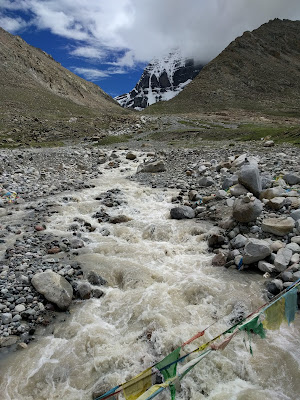
Though Manasarovar has been associated with origin of four rivers, no river originally originates from it. All have radius of 40-50 kms within range of Kailash Manasarovar. Indus Langchen Kambab (Elephant river), The Indus, called the Senge Tsangpo or Lion River in Tibetan, arises from the Lion Spring (Senge Kabab), 45 km north of Mount Kailash. Sutlej is designated as the Langchen Tsangpo, or Elephant River, in Tibetan mythology. In Tibetan mythology, the Brahmaputra is referred to as the Tamchok Tsangpo, or Horse River. The Karnali is Mapcha Tsangpo or Peacock River.August 6, 2016 (Day 16) - Darchen to Deraphuk (Day 1 of Parikrama)
Day 1 of Parikrama
Today was the first day of Parikrama. It was from Darchen to Deraphuk. We left around 10.15 am from hotel in Darchen to Deraphuk. Total distance is 19 kms and first 7 kms was covered by bus. I didn't take the kitchen staff as porter as they will leave you midway to cook meals. Instead, I decided to go with Nigam porter, which is randomly allotted through a lottery system. The porters on Tibetan side will not carry backpacks heavier than 6 to 7 kgs so make sure that your backpack weigh more than that. Since the main luggage stays at Darchen and you will get it only after completing parikrama, do make sure that you have eatables, important medicines and sufficient warm clothes. I couldn't carry my tripod due to weight restriction. In hindsight, I regret not carrying it myself.
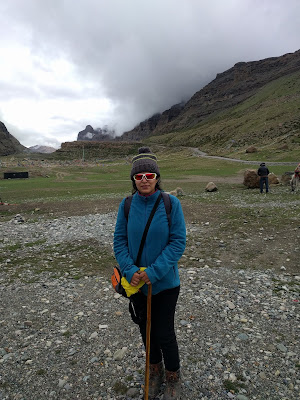 |
| Beginning of Kailash Parikrama |
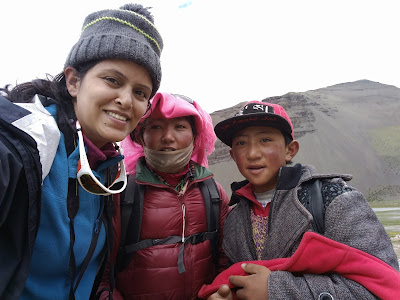 |
| Me and my porter |
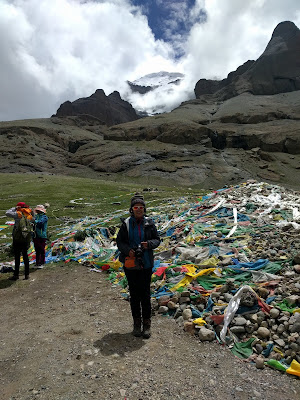 |
| West Face of Mount Kailash |
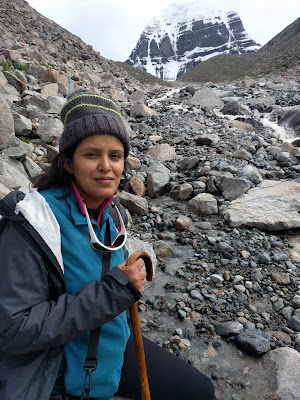 |
| On Way to Charan Sparsh |
| Lottery system for allocation of porters |
| Starting point of Parikrama |
| Yam Dwar |
Yam Dwar is situated in Tarboche, which is approximately 30 minutes drive from Darchen. The exact meaning of the Yam Dwar in Hindi is “the gateway to the God of Death”. It is the initial point of circumambulation of Mount Kailash. It is also known as Chorten Kang Ngyi, which means two legged Stupa in Tibet. It is said that, once you have reached here, you are in Kailash and equivalent to have performed the Parikrama. Yama is the deity who brings mortal souls to their onward journey. Symbolically, the Kailash region is likened to the divine world, separate from Earth. To enter this region, one must abandon the mortal self and hence pass through the Yama Dwar.
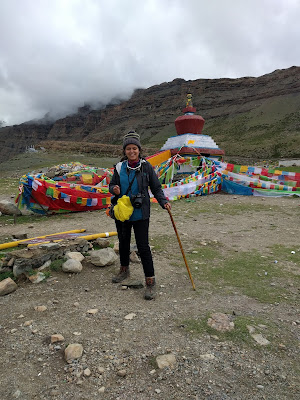 |
| At Yam Dwar |
Tarboche is also site of the popular Saga Dawa festival organised every year in late spring. Just next to it is a sky burial site where, as per tradition of the last ritual, the mortal remains of eighty-four Buddhist saints were fed to the birds of prey. Kora starts at Tarboche. In May in full moon, Sagar Dawa festival takes place. Near Tarboche is first of the four prostration places (Chakstal Gang). From the starting point of parikrama, one can see the Yam Dwar and south face of Mount Kailash also called Dakshina Murthi Shiva but since it was overcast we could not see the south face of Mount Kailash. Little later we entered the Lha Chu valley. Tarboche flag pole (4750m), which is another hour's walk. Tarboche flagpole, is one of the most important aspect of Tibetan spirituality. On “Saga Dawa” Tarboche, which is an impressive and capturing annual festival of Mount Kailash, this giant flagpole which has numerous prayer flags on it is brought down and replaced. This ritual is performed every year on the full moon day of the fourth lunar month of the Tibetan calendar to celebrate Sakyamuni's enlightenment.
Beyond Tarboche, the valley narrows down at an area called Sershong. After passing through a series of ruined Chörtens and a number of long mani (prayer) walls, the trail reaches a small bridge across the Lha-chu. The bridge is directly below Chuku Monastery. Chuku Monastery (4820m), founded in the 13th century by Götsangpa Gompo Pel, a Kagyupa-order master, is perched high on the hillside, a steep 15-minute hike above the valley. From the Chuku bridge, it's about 3 hrs walk to Deraphuk Monastery. One can see North Face of Mount Kaialsh from Diraphuk Monastary. Three lesser mountains are arrayed in front of Mount Kailash: Chana Dorje (Vajrapani) to the west, Jampelyang (Manjushri) to the east and Chenresig (Avalokiteshvara) in the centre.
| North Face of Mount Kailash as seen from Deraphuk |
Due to my ongoing illness, my health was not in great shape and I was breathing heavily although the first day is not that tough. I was amongst the last to reach Deraphuk by 4 pm. Most of the people were on ponies and few were on foot. Along the way, we got glimpses of rivulets, magnificent rocks with inscriptions of Buddhist mantras on them. I saw glimpse of West face of mount Kailash shrouded in clouds and then the first clear view of North face of Mount Kailash and I couldn't control my tears and bowed down in deep gratitude. Deraphuk literally means Cave of the female Yak horns". It gives the closest view of Mount Kailash (North face).
As I reached Deraphuk, I saw few people going further towards Charan Sparsh as we had got permission for it. Since I was too tired and exhausted, I sat near our hut with tea and Parle G. As I kept gazing at Mount Kailash, I felt a strong bolt of energy running through me and at that moment I knew I had to gather strength and reach Charan Sparsh. I told myself that this was a pilgrimage, a homage to my father and how could I leave it mid way. I was already late and clouds were looming above. Deraphuk is at an altitude of around 16700 feet and Charan sparsh goes upto 17800 feet covering distance of around 3 to 4 kms over uneven boulders and rocks. Some people gave up in the middle but I persisted. ONe thinks that one has reached Kailash but you still haven't. As you see Kailash more closer, you feel invigorated. I was dehydrated and exhausted but when I finally reached, I could not control my emotions. I wailed and wailed. Touching Mount Kailash was a defining moment of the Yatra. I could feel my father's spirit smiling from up above. I felt papa was there putting his hand on my head and blessing me. I took water from there, did some pooja and came back to Deraphuk. Basic accommodation is provided at Deraphuk. It was cold and windy. We didn't get permission to go to Ashthapad.
|
Charan Sparsh
|
As I was tired, I retired to bed after having dinner only to be woken up at 8pm by impending medical emergency. One of our young female yatris was feeling unwell. She was not feeling well since morning but didn't tell. She was having symptoms of HACE (High altitude cerebral edema), which is life threatening. She was drowsy, nauseous and had projectile vomiting and couldn't walk in straight line without falling. Her oxygen saturation was around 65-70. My worst fears came true. So I had to go into doctor mode and treat her and make her descend down to Taklakot to save her life. Thanks to our liaison officer, our medical kit was not with us. It felt so exasperating. I thankfully had dexona injection with me. I gave her oxygen, injection and other medicines. Someone had portable oxygen and we gave her some puffs. I told my LO that we immediately need to descend her to lower altitude. It was raining outside and permission needs to be taken from MEA to facilitate the evacuation, which takes time. All the yatris were around her giving her support and courage.
Another problem was our guide who said there is no need for evacuation and that is when little knowledge becomes dangerous.I put my foot forward that she needs to be evacuated otherwise she might not survive. Her situation was becoming worse and her drowsiness was increasing. Finally she was evacuated. Thankfully we were on our first day of parikrama and it was possible to evacuate her by car. She descended from 16500 feet to around 12000 feet, which was also not safe but she couldn't go beyond Taklakot. Her situation dramatically improved and I thanked Lord Shiva and my dad for giving me strength and opportunity to help someone.I was so tired and worn out and was thinking tomorrow is the toughest day and how will I do it. It was already 10.30 pm and we had to leave by 6.30 am tomorrow covering 24 kms and Dolma la at around 18500 feet.
Half an hour after I slept, I was woken up again and informed that another young male yatri was not responding. Another medical emergency. Another young guy had symptoms of HAPE (High Altitude Pulmonary Edema), low saturation, cough with frothy sputum .After whatever medicines were available, I took a call that both needed to be evacuated. Our Liaison officer made a Call to MEA and thankfully there was a dirt road from there to Taklakot. It was raining heavily and our guide was full of tantrums unwillingly to arrange a vehicle. After much chaos, a vehicle was arranged and both were descended to lower altitudes along with the portable oxygen. It was so exhausting and it was already 1 am. Tomorrow was a long day of crossing Drolma La covering around 25 kms. I prayed to Lord Shiva to give me strength for the coming day. Finally I dozed off. I woke at 3 am to pee and was bedazzled by the sight of milky way adorning north face of Mount Kailash. At that moment I was transfixed and rued why I didn't have my tripod on me. Also I was extremely tired of happenings of night and went back to sleep for the long day ahead.

Next part of blog will be about day 2 and 3 of Kailash Parikrama.Tips:
- Never take kitchen staff as your porter even if they speak Hindi because they will abandon you mid-way and move on to reach the campsite towards end to cook food, which would leave you without your luggage and supplies towards the end.
- Most of the porters assigned are Tibetan who speak neither Hindi or English, so most of the communication is done in sign language. Make sure your luggage does not exceed 6-7 kgs at the most and tell them to walk with you.
- Take plastic bottles to carry Manasarovar jal and jal from Kailash. Take M-Seal and tape/adhesive with you to secure the bottle cap.
- Female porters are more kind and considerate and would walk along with you. Don't forget to tip your porters adequately as they help you in such adverse conditions.
- Always keep your common medical bag with you.
- Hydrate adequately and carry Diamox and portable oxygen, if required.
- For your parikrama lasting 3 days, do not forget to carry energy bars, medicines, warm clothes, rain gear in your day pack.
IMPORTANT ADVICE: We should be blessed that we are chosen for this yatra and it is our responsibility to not litter and keep Devbhoomi clean. Carry your plastic wraps that you use with you and dispose them later. Try to clean the trail. Tell your porter not to litter. Gutka and chips packets lie everywhere. Particularly distressing was to see shores of Manasarovar littered with used underwear packets, ghee packets, used sanitary napkins etc. It was distressing and abominable. A place, which is so pious to us must be respected by all of us and deserves a conscious effort by all yatris to lead a cleaning drive as and when possible. Don't forget to do your bit, even if others are not doing it.
To be continued..
Click here to read previous part of Yatra
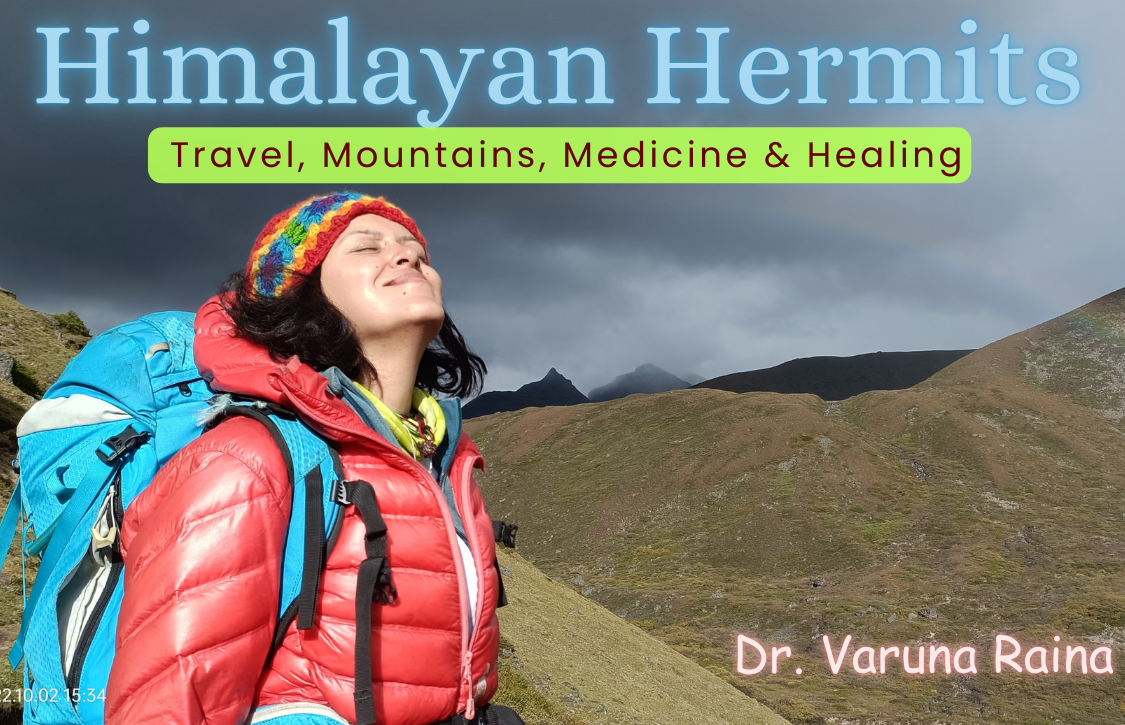


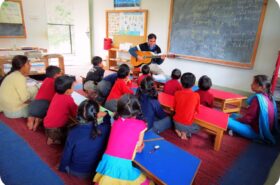


Kuntal Banerjee
Thank you for such a detailed description. It is really a great experience to read your travelogue. Eagerly waiting for the next expedition.
Dr. Varuna Raina
Thanks a lot 🙂
Dr. Varuna Raina
Thank you 🙂
Anonymous
This comment has been removed by a blog administrator.
Dr. Varuna Raina
Best wishes to all of you.May you have a blessed yatra 🙂
Dr. Varuna Raina
Thank you.
Best wishes for the yatra 🙂
Sarada
With God's grace and blessings we are getting ready for our trip on August 15th from Kathmandu. We are 16 ladies in our group of 40 members. Reading through your blog itself is an experience for me. Please give us your wishes for the success of our trip
Unknown
Dr, Your blog was very informative, we are planning our trip during August -2018. The tips are usefull. You have given a very elaborate account of your Yatra with Nice pictures.
R.Bhaskar Chennai.
Dr. Varuna Raina
Thank you Savita jee 🙂
Savita Patel
Thank you Varunaji for your detailed information and awesome view of Kailash Parikrama. Om Namah Shivay
Dr. Varuna Raina
Thank you 🙂
Sid Mukherjee
One of the most detailed counts of Kailash Parikrama I have read. May I be inspired to make my journey. Please complete the blog soon 🙂
Ramesh Shrama
Thank you Varuna Madam.Was waiting for the next part.God bless you for putting so much information and detailed blog.Om Namah Shivay.